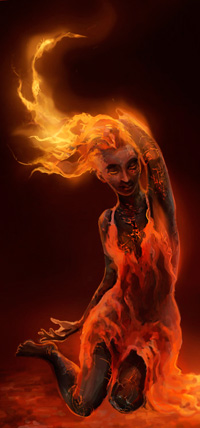Odin did not extend a friendly welcome to the witch Gullveig when she came to visit him. In his hall the High One and many other Aesir listened with loathing as she talked of nothing but her love of gold, her lust of gold. They thought that the worlds would be better off without her and angrily seized and tortured her; they riddled her body with spears.
 Then the Aesir hurled Gullveig on to the fire in the middle of the hall. She was burned to death; but out of the flames she stepped whole and reborn. Three times Aesir burned Gullveig’s body and three times she lived again.
Then the Aesir hurled Gullveig on to the fire in the middle of the hall. She was burned to death; but out of the flames she stepped whole and reborn. Three times Aesir burned Gullveig’s body and three times she lived again.
Then wherever she went, and she went everywhere, into every hall, Gullveig was given another name. The awed Aesir and their servants called her Heid, the gleaming one. She was a seer; she enchanted wands of wood; she went into trances and cast spells; she was mistress of evil magic, the delight of every evil woman.
When the Vanir heard how the Aesir had welcomed Gullveig, they were incensed as the Aesir had been by Gullveig’s gold lust; they swore vengeance and began to prepare for war. But there was noting that escaped Odin when he sat in his high seat in Valaskjalf; the Aesir, too, sharpened their spears and polished their shields. Very soon the gods moved against each other and Odin cast his spear into the host of the Vanir. Tat was the beginning of the first war in the world.
At first the Vanir gained ground. They used spells and reduced the towering walls of Asgard to rubble. But the Aesir fought back and surged forward and caused no less damage in Vanaheim – the world of Vanir. For a long time the battle raged to and fro, and the longer it lasted the clearer it became that neither side was likely to win.
Then the gods on both sides grew weary of war. Talk and truce seemed better than such turmoil. So leaders of the Aesir and the Vanir met to discuss terms. They argued about the war’s origins and whether the Aesir alone were guilty of causing the war or whether both sides were entitled to tribute. The end of the discussion was that the Aesir and Vanir swore to live side by side in peace, and agreed to exchange leaders as proof of their intentions.
So two leading Vanir, Njord and his son Freyr, made their way to Asgard. Njord’s daughter, Freyja, journeyed with them, and so did Kvasir, wisest of the Vanir. The Aesir welcomed and accepted them, much as they disliked the fact that Freyr and Freyja were the children of Njord by his own sister. They appointed Njord and Freyr as high priests to preside over sacrifices, and Freyja was consecrated a sacrificial priestess. She soon taught the Aesir all the witchcraft that was well known and in common use in Vanaheim.
For their part, the Aesir sent long-legged Honir and wise Mimir to live in Vanaheim. Honir was well built and handsome, a figure of substance. The Aesir thought he would make an enviable leader in war and peace alike. Mimir, like Kvasir, was held to be second to none in his understanding and wisdom.
The Vanir welcomed and accepted them. They at once appointed Honir to be one of their leader, and Mimir stood at his right hand. Always ready with shrewd advice. Together they were unfailing. When Honir was separated form Mimir, though, things were rather different. Standing alone in a council or meeting, and asked for his opinion, Honir’s reply was always the same: “Well, let the others decide.”
The Vanir began to suspect that the Aesir had tricked them and that they had got very much the worse in the exchange of leaders. And soon their suspicion turned to outright anger and thoughts of revenge. They sized wise Mimir and threw him to the ground and hacked off his head. They told one of their messengers to take it back to those who had so thoughtfully send it: Odin and the Aesir.
Odin and Mimir’s head had cradled it. He smeared it with herbs to preserve it, so that it would never decay. And then the High One sang charms over it and gave back to Mimir’s head to the power of speech. So it’s wisdom became Odin’s wisdom – many truths unknown to any other being.
From Snorri Sturluson’s Prose Edda, translation from “The Norse Myths” by Kevin Crossley-Holland.
